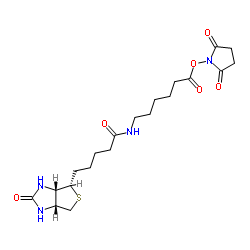Microfluidic chip with electrochemiluminescence detection using 2-(2-aminoethyl)-1-methylpyrrolidine labeling.
Xue-Bo Yin, Yan Du, Xiurong Yang, Erkang Wang
文献索引:J. Chromatogr. A. 1091(1-2) , 158-62, (2005)
全文:HTML全文
摘要
A tertiary amine derivative, 2-(2-aminoethyl)-1-methylpyrrolidine (AEMP) was successfully developed as electrochemiluminescence (ECL) probe within microfluidic chip using ECL detection in this paper. The system was characterized by the interaction between biotin and avidin. In principle, tertiary amine derivatives containing active group can be used as a potential alternative of traditional tris(2,2'-bipyridine)ruthenium(II) [Ru(bpy)3(2+)] label. Firstly, The ECL efficiency of AEMP was characterized via comparing with that of two coreactants enhancing Ru(bpy)3(2+) ECL, TPA and proline. At same condition, AEMP has a similar ECL efficiency to TPA, and much higher than proline. After AEMP reacted with NHS-LC-biotin (succinimidyl-6-(biotinamido) hexanoate), the products and their ECL were analyzed by directly injecting it in the microfluidic chip. A 4.5 cm microchannel was used to separate the mixture of AEMP and biotinylated AEMP. The present works indicated that AEMP has a good reactivity to the analytes containing carboxyl group with a similar ECL efficiency to TPA. Under optimal condition, the detection limits (based on 3 S/N) of AEMP was 2.7 microM. The system was also validated by the reaction between biotin and avidin. The calculated binding ratio between avidin and biotin based on the present method was 4.4.
相关化合物
| 结构式 | 名称/CAS号 | 分子式 | 全部文献 |
|---|---|---|---|
 |
生物素化-epsilon-氨基己酸-N-羟基丁二酰亚胺活化酯
CAS:72040-63-2 |
C20H30N4O6S |
|
Avidin binding of carboxyl-substituted biotin and analogues.
1982-03-02 [Biochemistry 21 , 978-984, (1982)] |
|
Ligation of major histocompatability complex (MHC) class I m...
1997-12-15 [J. Cell Biol. 139 , 1523-1531, (1997)] |
|
ATM-dependent phosphorylation of Mdm2 on serine 395: role in...
2001-05-01 [Genes Dev. 15 , 1067-1077, (2001)] |
|
Rapid and sensitive colorimetric method for visualizing biot...
1983-07-01 [Proc. Natl. Acad. Sci. U. S. A. 80 , 4045-4049, (1983)] |
|
Enhancement of immune cellular agglutination by use of an av...
1979-09-01 [Clin. Chem. 25 , 1572, (1979)] |